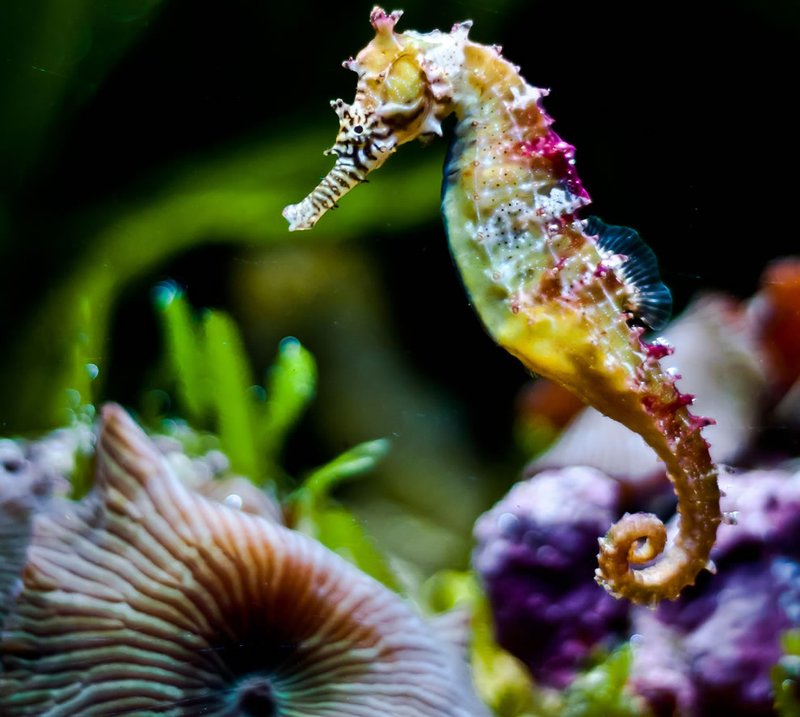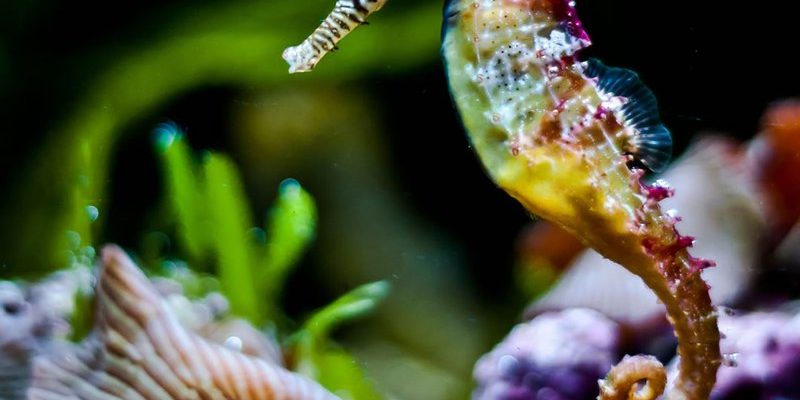
Seahorses are not your average fish. Their bodies, shaped like miniature horses, don’t rely on typical fish fins for movement. Instead, they use a tiny dorsal fin on their backs to propel themselves. This gives them a unique and almost whimsical navigation style. The way they communicate is equally intriguing. With no vocal cords, seahorses rely on body language and color changes to convey messages. Let’s dive deeper into the beautiful world of seahorses to understand how they navigate and communicate.
Unique Navigation Techniques of Seahorses
Seahorses are masters of stealth and precision when it comes to navigating their environment. Unlike other fish that dart around with speed, seahorses move slowly and deliberately. Their long tails act like anchors, allowing them to cling to seagrass or coral without getting swept away by currents. Think of it as a tightrope walker balancing high above the ground—each tiny movement counts!
One of the most interesting aspects of their navigation is how seahorses use their dorsal fin to propel themselves. This small fin, located on their backs, beats rapidly, allowing for small bursts of movement. Imagine someone using a tiny fan to push themselves through the air—it’s not about speed; it’s all about control. This method lets them navigate tight spaces in their habitats and evade potential predators.
Seahorses also have excellent vision that aids in navigation. Their eyes can move independently, allowing them to scan the surroundings for food and threats. You might picture a human turning their head from side to side to look around; seahorses do this with their keen eyes. It’s as if they have a panoramic view of their environment, making them aware of changes in their habitat.
Communicating Through Body Language
So, how do seahorses talk to each other? Unlike most creatures, they lack vocal cords. Instead, they rely heavily on body language and color changes to communicate their feelings and intentions. Picture a person using facial expressions instead of words—it’s similar for seahorses. Their ability to change colors helps them signal to potential mates or warn off competitors.
For example, during courtship, seahorses engage in a beautiful dance, often changing colors as they sway together. This color change isn’t random; it conveys their excitement and readiness to mate. It’s like a couple on a dance floor, communicating their feelings through movement and expression rather than spoken words.
Additionally, when threatened or stressed, a seahorse might display darker colors. This change is a signal to others nearby: “I’m not feeling safe right now.” It’s crucial for their survival, as it helps them alert others and avoid danger. Think about someone retreating into their shell when feeling vulnerable—that’s how seahorses express their feelings without a single sound.
Seahorse Courtship Rituals
The courtship rituals of seahorses are some of the most romantic in the animal kingdom. When a male and female seahorse meet, they often engage in an elaborate dance that can last for hours. During this time, they swim side by side, change colors, and even perform flips and turns. It’s like a synchronized swimming routine, showcasing their bond and compatibility.
This dance serves a purpose beyond attraction; it helps the pair strengthen their connection. This connection is vital, as seahorses are known for being monogamous and often mate for life. The more time they spend dancing together, the more likely they are to successfully mate. It’s a beautiful display of trust and communication, showcasing how these creatures rely on one another.
Once the female lays her eggs, the male seahorse takes over the responsibility of carrying them in a pouch on his abdomen. Here’s the twist: he offers the eggs protection and nourishment. Think of it as a shared parenting role; both play an essential part in the process. This unique arrangement highlights how teamwork is essential for their species’ survival.
How Environment Influences Navigation
The seahorse’s environment is a crucial factor in how they navigate and communicate. They prefer shallow waters, often found among coral reefs and seagrass beds. These habitats provide plenty of hiding spots, essential for their survival. Think of it like choosing a cozy café versus a busy street—one offers comfort, while the other may invite danger.
In these environments, seahorses use their coloration to blend in, avoiding predators by mimicking the colors and textures of plants. This camouflage not only helps them navigate safely but also supports their communication efforts. When they feel threatened, their color changes could serve as a warning, allowing them to remain hidden while signaling to others.
The availability of food also influences their movements. Seahorses are *suspension feeders*, which means they rely on tiny particles and plankton drifting in the water. They must navigate to where the food is plentiful, which requires not just skillful movement but also keen observation and awareness of their surroundings.
The Role of Social Structure in Communication
Seahorses are generally solitary creatures, but they can also be found in small groups. This social structure affects how they communicate. When they do gather, they engage in a variety of behaviors to establish their place within the group. Their intricate dances and color changes help convey status and relationships, much like how humans use body language and social cues in group settings.
During these interactions, seahorses will often display more vibrant colors when competing for mates or territory. It’s fascinating to see how their communication shifts based on social dynamics, just as one might change their tone or expressions in different social situations.
However, it’s important to note that stress in crowded environments can lead to more aggressive behaviors. This fluctuation showcases the delicate balance in their communication. Just as in any community, harmony is essential, but competition can crop up when resources are limited.
Conservation and the Future of Seahorses
As captivating as seahorses are, they are facing serious threats due to habitat loss, pollution, and overfishing. It’s crucial to protect their natural habitats—not just for their sake but for the entire marine ecosystem. The loss of seagrass beds and coral reefs directly impacts their navigation and communication, as these environments serve as their homes.
Conservation efforts, such as establishing marine protected areas, are essential to ensure seahorses can thrive. You might wonder why it matters—well, each species plays a role in the biodiversity of our oceans, and *seahorses are no exception*. Protecting them helps maintain healthy ecosystems that benefit us all.
By understanding the unique ways that seahorses navigate and communicate, we can appreciate their role in our oceans and work toward preserving their habitats for future generations. Just like a community coming together for a cause, we can play our part in ensuring these enchanting creatures stay a vital part of our marine world.
In closing, seahorses remind us of the delicate balance of life beneath the waves. Their intricate navigation and communication methods are not just fascinating; they are a testament to the wonders of nature. So, the next time you think of these little creatures, remember the art of their underwater dance and how they connect in a world so vast and deep.

